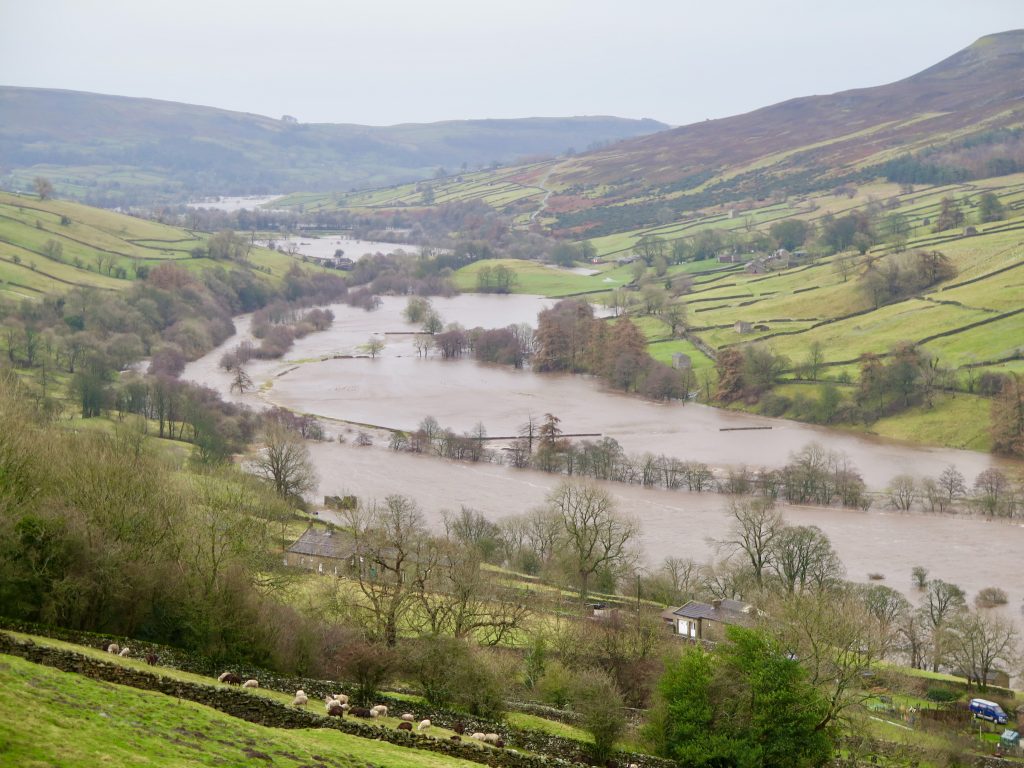
There’s no doubt that February has been a wet month for the northern Dales. For some this is no more than inconvenience, with muddy paths, flooded roads and grey skies becoming an accepted part of the daily grind. For others, particularly those who suffered during the 2019 flooding, it is a desperately anxious time spent obsessively watching forecasts, monitoring river levels, and stockpiling sandbags in the hope of averting disaster again.
It has undoubtedly been a grim start to the year, but can this watery onslaught be attributed to climate change? This isn’t a simple question to answer.
First you have to understand the difference between weather and climate. Weather is easy – this just describes the state of the lower levels of the atmosphere at any given moment in time. It may be hot, cold, windy, or (in our case recently) wet. A weather forecast can look ahead in time at what might happen, but it is still only a transient description of what might happen for a short period – a day perhaps.
One of the joys of UK weather is its extreme variability. It is entirely possible that we can have days of warm sunshine in March, or snow showers in June. Indeed, this is completely normal – there were warm March days back in pre-Industrial times, and there were snow-showers in June long before humans came along. In isolation, you cannot look at these events and draw any meaningful conclusions about whether they are a consequence of climate change – they are just part of the rich variability that the UK weather can throw at us.
It is only possible to look at these individual weather events, and draw useful conclusions from them, when you average them out over a longer period. This is what we call ‘climate’, which is the long-term average of all of the weather, typically taken over a period of 30 years or so.
You can immediately see that a couple of periods of heavy rainfall in a 30-year period are going to have virtually no impact on the overall climate average – they will be lost in the noise. But when you get more, and more, of those events, they do start to affect that long-term climate average, and this is what we’re seeing now.
The Met Office reported this week that February 2020 was the wettest February on record for the UK, and that this is the 5th wettest winter, since records began in 1862. It certainly feels like it. But they are still quite correctly cautious about linking this to climate change. The Met Office website states (in reference to the recent wet weather):
“Since 1998, we have seen six of the ten wettest years on record. However, rainfall patterns in the UK have always shown a large range of natural variation, which makes it more difficult to unambiguously identify long term trends linked to climate change. However, wetter winters have been observed and is consistent with what we expect to happen in the future with continued climate change.”
Again, a single wet month, or winter, may be just ‘noise’ in that 30-year climate average. But if we get lots of those wet winters, as has been the case over the last few years, then that does start to swing the long-term average. And therefore it is fair to say that what we are seeing does look alarmingly like a direct impact of climate change in our Dales home.
There is an aside to this, which is perhaps no surprise to those who witnessed the local flooding of July 2019. It is not just the frequency of these events that is increasing, but also the severity – these are being described as ‘extreme weather events’.
However, the same consideration applies as above – it is impossible to look at a single storm and conclude that its severity was a consequence of climate change. Arguably the worst storm ever to hit the UK was in 1703. This killed thousands of people and swept away the Eddystone lighthouse, but was long before the modern industrial era, when anthropogenic carbon emissions started warming the atmosphere.
It is only when you look at the average severity of storms over a very long period that you can begin to assess whether they are getting worse. And indeed, the Met Office are busy making this kind of assessment. In reviewing the severity of Storm Desmond in 2015, they (again, cautiously) estimated that such events are made 59% more likely by climate change.
So next time the heavens open (it won’t be long), and someone points to the sky and says ‘that’s climate change!’, you can scathingly explain to them that it’s impossible to judge that from a single isolated rainfall event. But if they point to the sky and say ‘this rain is due to climate change consistent with an increasing average rainfall trend measured over 30 years’ then give them a knowing nod and lend them your umbrella.